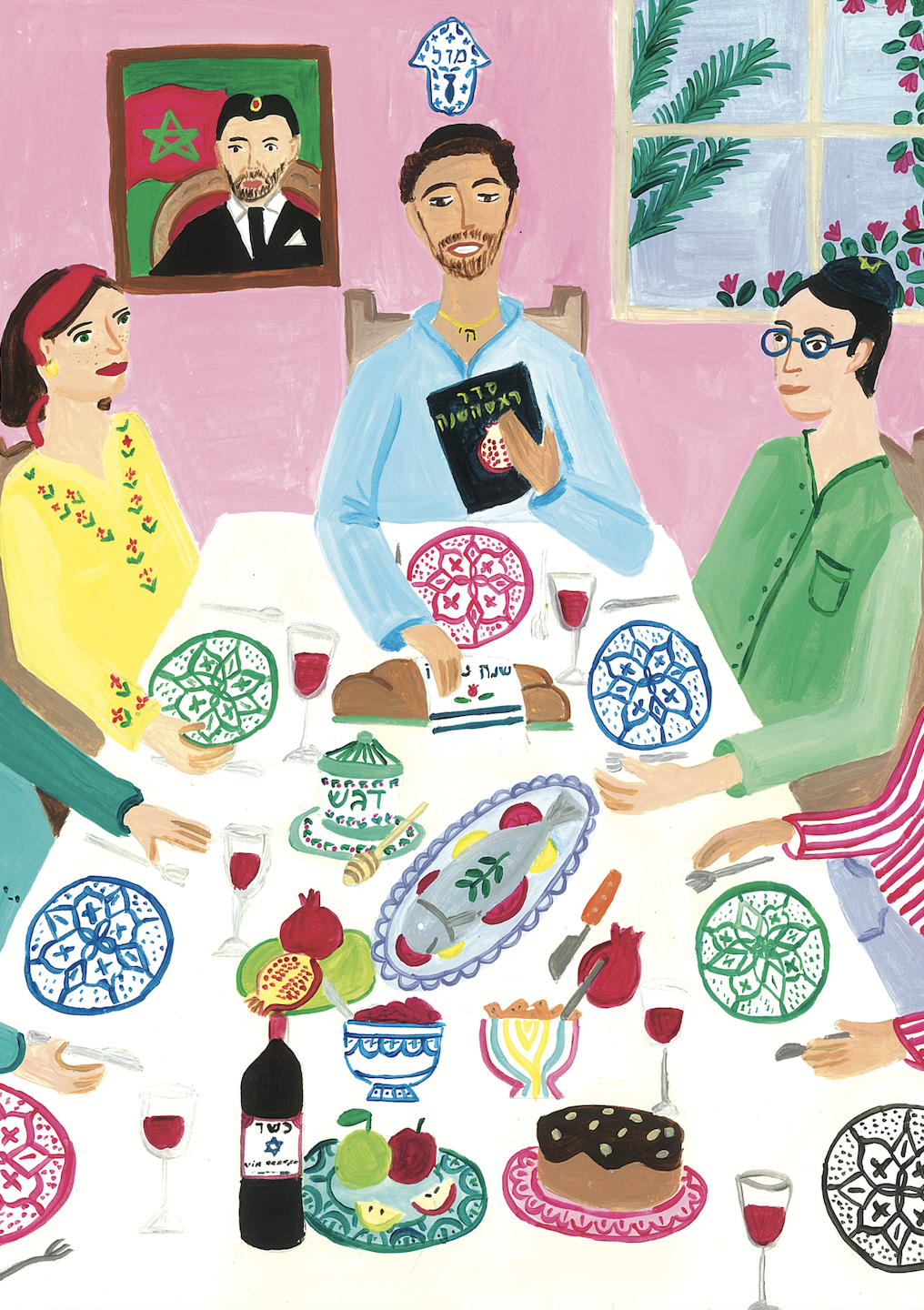My favorite visual artists have the ability to transport me to faraway places — places I already know, places I’ve never been, places that exist only in their imaginations. Stand in front of a Monet and you’re in Normandy; visit a Yayoi Kusama Infinity Room and glimpse an alien landscape no one else could have made.
I experienced this sudden traveling while scrolling on Instagram in my living room when I stumbled across Myriam au Citron’s work. Her colorful, bright paintings made me feel the atmosphere and energy of Tangier, in northern Morocco, where she’s based. Among other images of the city, she paints Jewish life — like Shabbat and the High Holidays — as celebrated in Morocco, making me feel nostalgic for traditions that are not my own.

Myriam’s art wasn’t always her primary focus: Food was what brought her to Morocco. Born in France to a French mother and a Moroccan father, she loved the flavors of her father’s cooking. They inspired her to move to Chefchaouen in 2016, where she opened a restaurant with her sister and started painting her surroundings in order to decorate the place. But when the lockdown forced restaurants all over Morocco to close their doors, drawing took up more and more of her days. Now her Instagram account, @myriamaucitron, has over 10K followers.
I spoke to Myriam over email about the artist she loves most, her favorite High Holiday foods, a perfect Tangier day and more.
What is your family history and background? Where did you grow up, where do you live now?
I am French-Moroccan; I lived in Lille in the north of France until I was 24, when I moved to Tangier. My father, from northern Morocco, lived in Casablanca before studying in Paris. My parents met on vacation in the Balearic Islands and settled in Lille, my mother’s home city, where my sister Sarah and I were born. We discovered Morocco through our parents’ cuisine, stories and travels.
Your images are often full of color and festivity — and food! What Jewish Moroccan foods make you think of the time of year when the High Holidays fall?
Rosh Hashanah is, for me, synonymous with sweet and salty plates. Lamb with plums served with a sweet couscous made with orange blossom and cinnamon is the must for a successful Rosh Hashanah (in my opinion)! Also, not Moroccan, but we like to do the lekah honey cake… it is the perfect way to finish the meal. To break the fast in Morocco we often find soups like harira, made with celery, tomatoes and chickpeas and accompanied by dates or dried figs.

What are your Rosh Hashanah and Yom Kippur traditions, if you observe the holidays?
Tradition is above all getting together, sharing preparations and remembering the essentials. I particularly like the Rosh Hashanah seder; I like the symbolism through the presence of each food, the pomegranate, the dates, and honey… it is also a way to recall Morocco through North African cuisine.
The Rosh Hashanah painting is inspired by a visit to Ashdod in Israel, where I was marked by the history and attachment of the Moroccan Jewish community to the kingdom.
What media/materials do you usually like to work in?
I paint on thick paper (300 to 400 grams) after drawing my ideas from previous sketches in wood pencil. The last step is colors! I use a mixture of acrylic and gouache.
Favorite visual artists?
Chagall!! I discovered him when I was 16 in an exhibition called “The Thickness of Dreams.” I was deeply touched by his poetic works, and all the details present in the works — the theater sets, but also the incredible ceiling of the Paris opera. It is surely his painting, “The Lemon Rabbi,” which made me choose the nickname “Myriam with lemon” for myself.
Where else do you draw inspiration from?
I always liked drawing but I didn’t really have a style. I used felt illustration for my marketing projects. It was really my arrival in Morocco that opened something in me. Surely the colors of the north, the green, the fabrics, the souks (markets)… the spontaneity of the scenes of daily life are delicious food for the imagination for me, who grew up in France.

How would you describe the feeling/personality of Tangier?
For me, Tangier is really special and unique. When I was younger, I didn’t like Tangier — I couldn’t understand the city, which is more intimate than Marrakech, for example. Then, over time, I fell in love with it: the architecture, the presence of nature, mythical addresses, stories. I want to be part of this city. Now I can’t see myself living anywhere else but in this poetic city, planted in Africa and looking towards Europe. You can see the ocean from many places; I have the impression that the houses hide wonderful stories. I feel inspired and have room to breathe.
You’re making me want to visit! Any Tangier recommendations, in case your images make others want to go?
What I love about Tangier is walking around Marshan and looking at the magnificent old houses… then losing yourself in the kasbah. You can even sleep at the Tangerina, which, to me, is the most beautiful hotel… then go down to the Place du 9 Avril, get some jben (local cheese) and fruits at the souk, and head to Rif Cinema for a tea. If you can, take a car to Perdicaris Park, where I love to walk, and then continue to the beaches for lunch at the Ocean Restaurant.
What’s next for you?
I am working on opening a pastry shop and salon de thé in Tangier with my sister. I wish for it to happen very soon. I also hope I will continue painting this Morocco and convey all the love and fascination I have for this colorful country.



